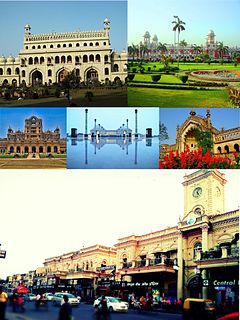
Buckingham Palace is the London residence and administrative headquarters of the monarch of the United Kingdom. Located in the City of Westminster, the palace is often at the centre of state occasions and royal hospitality. It has been a focal point for the British people at times of national rejoicing and mourning.

The Rashtrapati Bhavan is the official home of the President of India located at the Western end of Rajpath in New Delhi, India. Rashtrapati Bhavan may refer to only the 340-room main building that has the president's official residence, including reception halls, guest rooms and offices, also called the mansion; it may also refer to the entire 130-hectare Presidential Estate that additionally includes huge presidential gardens, large open spaces, residences of bodyguards and staff, stables, other offices and utilities within its perimeter walls. In terms of area, it is the largest residence of any head of state in the world.

The Government Botanical Garden is a botanical garden in Udhagamandalam, near Coimbatore(Ooty), Tamil Nadu state, India laid out in 1848. The Gardens, divided into several sections, cover an area of around 55 hectares, and lie on the lower slopes of Doddabetta peak. The garden has a terraced layout. It is maintained by the Tamil Nadu Horticulture Department.

Guindy is one of the important neighborhoods of Chennai (Madras), Tamil Nadu, India. The Kathipara junction where Anna Salai, Mount-Poonamallee Road, Inner Ring Road, 100 Feet Road or Jawaharlal Nehru Road, and GST Road meet here. It is one of the important nodal points of road traffic in the metropolitan area. This junction serves as the entry point to the city limits from the suburbs. It is surrounded by Saidapet in the north, Kotturpuram and Adyar towards the east, Velachery in the south and Adambakkam and St. Thomas Mount in the west. Guindy is home to many important landmarks in the city, the most famous amongst them being the Guindy National Park — the only National Park in the country within city limits. It also serves as a main hub for several small and medium scale industries. Transportation to/ from the neighborhood is catered by Guindy railway station and Guindy metro station.

Raj Bhavan is the official residence of the Governor of West Bengal, located in the capital city Kolkata. Built in 1803, it was known as Government House before the independence of India.
Raj Bhavan is the official residence of the Governor of Arunachal Pradesh. It is located in the capital city of Itanagar, Arunachal Pradesh. The present Governor of Arunachal Pradesh is Padmanabha Acharya.

Raj Bhavan or Raj Bhawan is the official residence of the Governor of Bihar. It is located in the capital city of Patna, Bihar. The construction of building started in 1912 and was completed in 1917. It was designed by New Zealand-born architect Joseph Fearis Munnings.
Raj Bhavan is the official residence of the Governor of Jharkhand. It is located in the capital city of Ranchi, Jharkhand. The present governor of Jharkhand is Draupadi Murmu.
Raj Bhavan is the official residence of the Governor of Kerala. It is located in the capital city of Thiruvananthapuram, Kerala. Built in 1829 as Palace Guest house of Travancore Government Guest, this heritage structure hosts the present governor of Kerala is Justice (Retd) P Sathasivam.
Raj Bhavan, literally the "Governor's Residence," is the official residence of the Governor of Tamil Nadu. It is located in Chennai, the capital city of Tamil Nadu.
The Tamil Nadu Dr. M.G.R. Medical University, or TNMGRMU for short, is a government medical university centered in Chennai, Tamil Nadu, India. It is named after the former Chief Minister of Tamil Nadu, Dr. M.G.Ramachandran (M.G.R.) and is the second-largest health sciences university in India.
Raj Bhavan of Pachmarhi is the Summer residence of the Governors of Madhya Pradesh, It is located in the city of Pachmarhi, Madhya Pradesh.

Fernhill Palace was the erstwhile summer residence of the Maharaja of Mysore. The first Fernhills bungalow was built in 1844 as a private residence in the hill station Ooty in the Indian state of Tamil Nadu. The palace resembles a Swiss Chalet. Its carved wooden bargeboards and ornamental cast iron give it that characteristic appearance. The palace grounds accentuate the alpine look of the place with its manicured gardens, firs and cedars. There is a church-like indoor badminton court on the grounds.

The Government Rose Garden is situated on the slopes of the Elk Hill in Vijayanagaram of Ooty town in Tamil Nadu, India at an altitude of 2200 meters.

Ooty lake is located in Ooty in the Nilgiris district, Tamil Nadu, India. It covers an area of 65 acres. The Boat house situated by the lake, which offers boating facilities to tourists, is a major tourist attraction in Ooty.

Adam's fountain is a public display fountain in Charring cross, Ooty. It was built in 1886 as a memorial to a Governor of Ooty, who was very famous in the region during his tenure. The total cost of finishing the fountain was between Rs. 13,000 to Rs. 14000, which was funded through public funding.

Rajaji Hall, previously known as the Banqueting Hall, Madras, is a public hall in the city of Chennai, India used for social functions. The hall was built by John Goldingham to commemorate the British victory over Tipu Sultan in the Fourth Anglo-Mysore War.

The second Raj Bhavan of Uttarakhand is situated in Nainital. In the pre-Independence era, Nainital served as the summer capital of United Provinces and this building, built like a Scottish castle was christened as the "Government House". Raj Bhavan was built by British as residence of Governor of then North West Province. The beginning of construction of Raj Bhavan was started in April 1897 and it took two years to complete. It is built on European pattern and based on Gothic Architecture. The designers of Raj Bhavan (Nainital) were Architect Stevens and the Executive Engineer FOW Ortel. After Independence it was renamed as Raj Bhavan.














